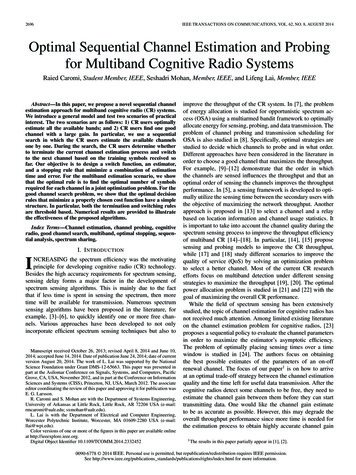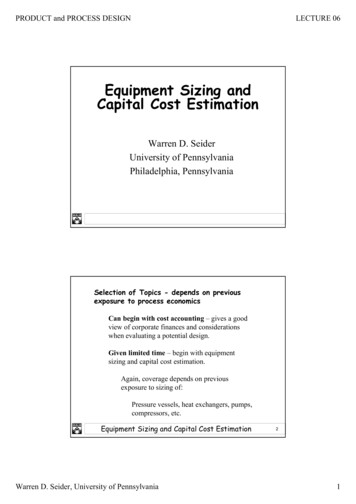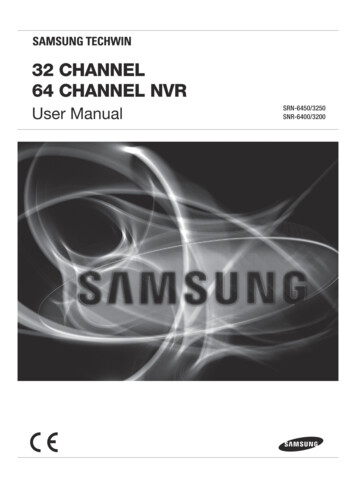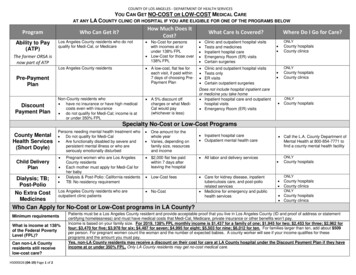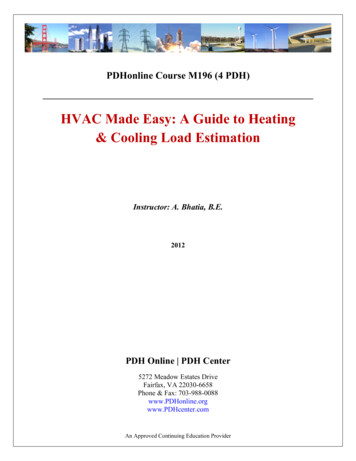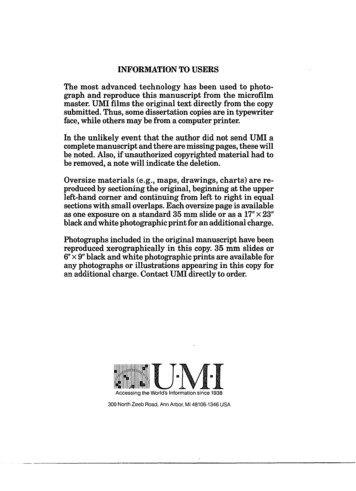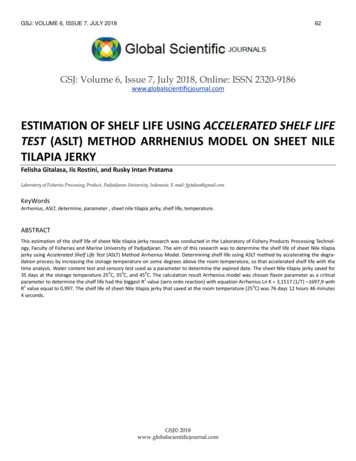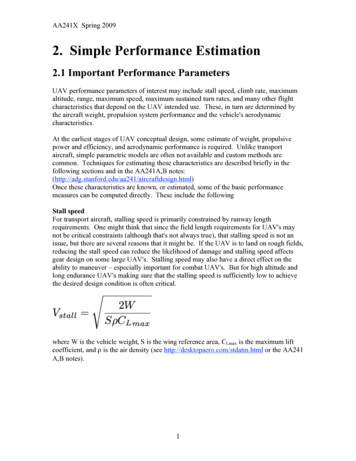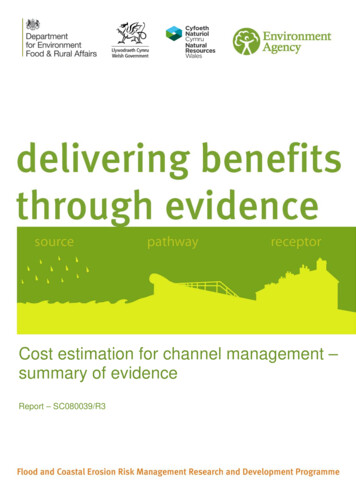
Transcription
Cost estimation for channel management –summary of evidenceReport – SC080039/R3
We are the Environment Agency. We protect and improve theenvironment and make it a better place for people and wildlife.We operate at the place where environmental change has itsgreatest impact on people’s lives. We reduce the risks to people andproperties from flooding; make sure there is enough water for peopleand wildlife; protect and improve air, land and water quality andapply the environmental standards within which industry canoperate.Acting to reduce climate change and helping people and wildlifeadapt to its consequences are at the heart of all that we do.We cannot do this alone. We work closely with a wide range ofpartners including government, business, local authorities, otheragencies, civil society groups and the communities we serve.This report is the result of research commissioned by theEnvironment Agency’s Evidence Directorate and funded by the jointFlood and Coastal Erosion Risk Management Research andDevelopment Programme.Published by:Environment Agency, Horizon House, Deanery Road,Bristol, BS1 5AHAuthor(s):Paul Jones, JBA ConsultingKevin Keating, JBA ConsultingAngus Pettit, JBA Consultingwww.environment-agency.gov.uk Environment Agency – March 2015All rights reserved. This document may be reproducedwith prior permission of the Environment Agency.The views and statements expressed in this report arethose of the author alone. The views or statementsexpressed in this publication do not necessarilyrepresent the views of the Environment Agency and theEnvironment Agency cannot accept any responsibility forsuch views or statements.Email: tion Status:Publicly availableKeywords:Whole life costing, cost estimation, channelmanagementResearch Contractor:JBA ConsultingSouth Barn, Broughton Hall, SkiptonNorth Yorkshire BD23 3AE01756 799919Environment Agency’s Project Manager:Adam Baylis, Evidence DirectorateFurther copies of this report are available from ourpublications orator(s):John Chattertonor our National Customer Contact Centre:T: 03708 506506Project Number:SC080039/R3Email: enquiries@environment-agency.gov.ukiiCost estimation for channel management – summary of evidence
Evidence at theEnvironment AgencyEvidence underpins the work of the Environment Agency. It provides an up-to-dateunderstanding of the world about us, helps us to develop tools and techniques tomonitor and manage our environment as efficiently and effectively as possible. It alsohelps us to understand how the environment is changing and to identify what the futurepressures may be.The work of the Environment Agency’s Evidence Directorate is a key ingredient in thepartnership between research, guidance and operations that enables the EnvironmentAgency to protect and restore our environment.This report was produced by the Scientific and Evidence Services team withinEvidence. The team focuses on four main areas of activity: Setting the agenda, by providing the evidence for decisions; Maintaining scientific credibility, by ensuring that our programmes andprojects are fit for purpose and executed according to international standards; Carrying out research, either by contracting it out to research organisationsand consultancies or by doing it ourselves; Delivering information, advice, tools and techniques, by makingappropriate products available.Miranda KavanaghDirector of EvidenceCost estimation for channel management – summary of evidenceiii
Executive summaryThis summary of evidence provides indicative costs and guidance on a number ofchannel management and maintenance aspects for natural and engineeredchannels/banks.Channel managementKey costcomponentsOperation and maintenance costs can make up a large proportionof total revenue spend for organisations with responsibility tomaintain channels. The most important cost components aretherefore operational (inspection) and maintenance costs (desilting, bank repairs, obstruction removal and so on).Management of environmental features within channels can be asignificant issue, resulting in additional costs.Capital costs of new channels may be significant – the availability ofunit costs for new channels is limited and will be highly variable.Key assettypes Natural channels and banks Engineered channels and banksData reviewedin specificguidanceKey reports and data sources include: Environment Agency Unit Cost Database (capital costs) Environment Agency Maintenance Standards (maintenancecosts) limited information on unit costs for narrow new channels in theEnvironment Agency Unit Cost Database Estimating Guide IDB unit costs provided by the Shire Group of IDBs indicative costs and case studies associated with dredging SEPA indicative costs associated with hard and soft bankprotection measuresOther relevantdataLocal or proxy records such as data from Environment AgencySAMPs and local authority informationRelative costimportanceEnabling costsNot applicable unless new channels areconstructed.Capital costsNot applicable unless new channel areconstructed.Maintenance costsVariable operation and maintenance costsare critical for channels relative to other costelements.Other costconsiderationsVariable costs. May need to considerdredging, bankrestoration/reinforcement/repair costs.ivCost estimation for channel management – summary of evidence
CostInitial concept/estimationnational appraisalmethodologyStrategic, regional, orconceptual designPreliminaryfeasibility/designApproximate O&M range of rates availableApproximate O&M range of rates availableCosts built up using guidance to allowappraisers to define type and frequency ofworks.Design lifeinformationNot applicable unless hard engineering works are used to create achannel, in which case the design life of the materials/structures isrelevant.Quality ofdataApproximate unit rates for the maintenance aspects are availablealong with a number of historical data and reference projects.Available data for unit costs are provided, although cost curveinformation is not available. Unit rates and examples from a number ofsources are available.AdditionalguidanceChecklist of factors likely to influence maintenance costs and keyfactors to consider for detailed costs estimationList of R&D and general design guidanceCost estimation for channel management – summary of evidencev
AcknowledgementsThe authors wish to thank the Project Board (Ian Meadowcroft, Linsay Hensman andAdam Baylis) and the Environment Agency, local authority and Internal Drainage Boardrepresentatives and operational staff who were consulted.viCost estimation for channel management – summary of evidence
Contents1Flood mitigation measure – channel management11.1Data requirements11.2Channel and bank operation and maintenance11.3Channel dredging81.4Capital costs associated with new channels111.5Bank protection measures141.6Hard bank decommissioning costs191.71.8Other cost estimation requirementsCost estimation methodology19201.9Case studies211.10Checklist231.111.12R&D and general design guidanceReferences2425Table 1.1Table 1.2Table 1.3Table 1.4Table 1.5Table 1.6Table 1.7Table 1.8Table 1.9Table 1.10Table 1.11Table 1.12Table 1.13Table 1.14Table 1.15Table 1.16Table 1.17Table 1.17Open channel maintenance unit costs ( /km/year)Engineered channel maintenance unit costs ( /km/year)Weighting and scoring approach to work out appropriate cost within rangeAverage maintenance costs per kmIDB watercourse maintenance cost per km by methodSuggested annual maintenance activities and frequenciesSuggested intermittent maintenance activities and frequenciesIndicative costs for channel dredgingKey factors affecting channel management costsUnit costs for new channel constructionEstimated channel excavation costsTypical work items for new channelsKey factors affecting new channel capital costsIndicative hard bank reinforcement costsIndicative soft bank reinforcement costsSoft bank reinforcement supply and installation costsIndicative costs for bioengineering design elementsIndicative hard bank decommissioning costs3345577910111213141517181819Figure 1.1Figure 1.2Figure 1.3Figure 1.4Figure 1.5Average annual costs per km by length of watercourse maintainedFlow diagram for channel whole life costsBioengineering on the Gwendraeth FawrBioengineering on the River PinnBioengineering on the River Ebbw520212223Cost estimation for channel management – summary of evidencevii
1Flood mitigation measure –channel managementChannel management and maintenance works are performed on rural channels withnatural banks and engineered channels by a range of organisations and for a range offlood risk and environmental aspects providing multiple benefits. The purpose ofchannel management and maintenance works is to: retain flow capacity and conveyance sustain riparian rights to the ordinary use of water flowing past their land manage water levels to sustain land functions retain and protect flora and fauna dependent or resident within thewatercourseFurther general guidance on design and maintenance aspects are provided in theEnvironment Agency’s Fluvial Design Guide. Additional links to research and morespecific guidance are provided at the end of this evidence summary.1.1Data requirementsA number of standard cost parameters are required for channel management. Theseinclude the following aspects: capital costs of new channels (if applicable) operational costs (inspection) maintenance costs (de-silting, bank repairs, obstruction removal and so on)Capital expenditure may be required where new channels are constructed such as partof a river realignment scheme, an existing channel is re-graded, bank slope stability isan issue or river restoration measures are necessary. While river restoration measuresare covered elsewhere in the guidance, the capital costs associated with theconstruction of new channels are provided in this evidence summary.There is also a link between riverbank protection and the use of bioengineeringsolutions that can provide alternative sustainable solutions for riverbank protection,bankside stabilisation and marginal vegetation habitats. The costs associated withthese sorts of measures are provided in this evidence summary for completeness.1.2Channel and bank operation and maintenanceChannel maintenance costs as a percentage of total expenditure represented anaverage of 35% for all Internal Drainage Boards (IDBs) in the 2009-2010 financialyear. 1 Some 46% of the estimated frequent maintenance activities identified for allEnvironment Agency System Asset Management Plans (SAMPs) for the 2010-20111Based on IDB1 returns for 2009-2010.
financial year related to maintaining channel conveyance. For medium and lowconsequence systems, this proportion increased to 52% and 61% respectively 2.Channel and bank operation and maintenance (O&M) activities will include a number ofinspection and maintenance activities. Maintenance activities will include both frequentand annual management aspects to maintain conveyance, as well as less intermittentactivities such as dredging/de-silting.Channel operation and maintenance costs vary according to the type of channel (openor engineered), the responsible authority (Environment Agency, local authority or IDB)and the target grade (including frequency of inspection/maintenance).Channel inspection activities may include the following depending on the channel typeand the flood risk associated with the watercourse: operational inspections (includes debris/blockage clearance whererequired) pre storm inspections to ensure watercourse is fully clear of debris or postflood inspections to check the need for urgent repair works (criticalchannels only) visual asset condition assessments (typically risk-based inspectionfrequency as a trigger for more detailed inspection) hydromorphological evaluationsChannel maintenance activities may include the following: weed control (by hand or mechanical means) obstruction removal bank clearance (including removal of small trees and shrubs) intermittent works such as bank protection, dredging and repairsPrevious national assessments (Environment Agency 2010a) estimated that: inspection costs were approximately 2 per metre engineered channel maintenance was 5 per metre natural channel maintenance was 2 per metreIt is not clear how these estimates were derived other than by engineering judgement.Newman (2007) noted that British Waterways carried out hydromorphologicalevaluations every six years on rivers at an estimated cost of 300–500 per km.These values may be appropriate for very broad level analysis, although more recentstudies (discussed in the following sections) provide additional detail that may be moresuitable.1.2.1Environment Agency O&M costsThe annual O&M costs given in Tables 1.1 and 1.2 for natural and engineeredwatercourses respectively are based on Environment Agency Maintenance Standards(Environment Agency 2010b). Costs are provided for three target condition gradesbased on the Environment Agency Condition Assessment Manual (CAM) (Environment2Based on SAMP-IT output provided by Linsay Hensman, December 2010.2Cost estimation for channel management – summary of evidence
Agency 2006). Costs for condition grade 1 (Very Good) are not provided as these arenot standard asset management targets for the Environment Agency. These costs arederived from experience, contract rates and estimated rates for a range of activities.They represent indicative costs and provide a broad range of costs per year perwatercourse length depending on the method of vegetation clearance. These costs inparticular have very wide range, and careful estimation and determination of theappropriate costs for any given watercourse is required. The Environment Agency’srecommended approach is discussed further below.Table 1.1 Open channel maintenance unit costs ( /km/year)Target gradeManual clearanceMechanical clearanceGrade 22,830–25,345830–8,445Grade 31,025–20,770260–5,235Grade 4710–5,035120–1,210Notes:Natural channels are those with natural banks, typically found in rural andsuburban reaches.Maintenance activities include grass control, weed control, tree work,operational inspections, reactive obstruction removal and de-silting.Target grades vary from 1 (Very Good) to 5 (Very Poor).Environment Agency (2010b)Source:Table 1.2 Engineered channel maintenance unit costs ( /km/year)Target gradeManual clearanceGrade 2985–6,040830–5,330Grade 3580–2,730500–2375Grade 4165–995165–815Notes:Source:Engineered channels are those with an engineered bank made frommaterials such as concrete, brick, steel or timber. This type of channel ismost likely to be present in urban reaches.Maintenance activities include vegetation clearance and channel repairworks, operational inspections, reactive obstruction removal and de-silting.Environment Agency (2010b)As the range of costs for watercourse maintenance is very wide, the EnvironmentAgency Maintenance Standards document recommends use of a weighting andscoring methodology to work out an appropriate point within the range based on thefactors listed in Table 1.3 that influence O&M costs. These factors are based onjudgement and expert opinion. Ongoing data reviews and cost capture of maintenanceactivities will help to inform this procedure in the future.
Table 1.3 Weighting and scoring approach to work out appropriate cost withinrangeFactor influencing maintenance costsWeightNatural watercoursesDifficult access (distance to work site, protected sites/species,overhead power cables)2Location known for excessive fly-tipping2Urban location with a greater requirement for reactive obstructionremoval1Invasive weeds1Protected species which may require a more sensitive environmentaloption1Engineered watercoursesDifficult access (distance to work-site, protected sites/species,overhead power cables)2Invasive weeds1Protected species which may require a more sensitive environmentaloption1Notes:Source:A score between 0 and 2 is given to each factor. Scores are multiplied bythe weight to give a score between 0 and 14. A value of 0 corresponds tothe lower end of the cost range and a value of 10 corresponds to the higherend of the unit cost range.Environment Agency (2010b)1.2.2IDB maintenance costsMaintenance costs for IDBs account for approximately 30–45% of total expenditure(JBA 2006). The IDB Review project carried out in 2006 reviewed the averagemaintenance costs per km of watercourse for IDB maintained assets. The averagecosts per km were 660 for all IDB regions, but varied between 602 and 1,364 perkm as shown in Table 1.4. Unfortunately no information on how these costs vary withcondition of channel was available to investigate this relationship further.This analysis was repeated four years’ later using more up-to-date information providedby IDBs via the IDB1 forms submitted to Defra. 3 Average costs had increased over theperiod to 804 per km (Table 1.4). The maximum costs for any one IDB are in theregion of 3,700 per km, although this may represent costs for dealing with one-offinfluences such as dealing with flood events or higher intermittent costs for certainyears for example.3Personal communication from Michael Panteney, Defra, Flood Management Division.4Cost estimation for channel management – summary of evidence
Table 1.4 Average maintenance costs per kmCategory2004-2005 season2009-2010 seasonAll IDBs 660 800Grouped IDBs 600 780Standalone IDBs (income 100,000) 840 1,130Standalone IDBs (income 100,000) 460 380Environment Agency administered IDBs 1,360 1,106As part of this study, JBA Consulting reviewed data provided for 39 catchmentsmanaged for the Shire Group of IDBs. Annual watercourse maintenance expenditurefor each of these catchments was assessed for the 2007-2010 period. Two types ofcatchments were chosen – those where the maintenance is carried out in-house andthose where external contractors were used. Costs included all watercoursemaintenance activities such as flailing and de-weeding. The cost of channelmaintenance was found to vary significantly, with direct labour costs much higher thanthose of external contractors as shown in Table 1.5 and Figure 1.1.Table 1.5 IDB watercourse maintenance cost per km by methodExternal contractorsIDB direct labourMaximum 1,595 2,071Minimum 331 458Average 542 1,836Figure 1.1 Average annual costs per km by length of watercourse maintainedThe lower costs for maintenance work that is contracted out reflect the greaterefficiency and better cost control by this method. An advantage of direct labour iseasier availability. In addition, the employment of direct labour is not limited to justmaintenance work on that particular District’s watercourses and pumping stations; for
example, direct labour can be hired out to complete additional maintenance works forother IDBs and organisations.1.2.3Detailed O&M costs and guidanceO&M costs depend on: level of inspection and annual maintenance required type of watercourseOperational inspection frequenciesOperational inspections are an essential component for setting maintenance targets.However, they can constitute a large long-term cost because of the requirement fortrained inspectors to assess sites regularly to ensure that channels remain in goodcondition.Channels and defence structures for which the Environment Agency is responsible forare assigned an inspection frequency for each river reach. Inspection frequencies varyfrom six to 24 months.The determination of inspection frequency takes account of risk which considers boththe consequence of failure and the probability of failure.The consequence of failure is based on factors such as land use, population,environmental designations, topography and development proposals.The probability of failure is influenced by the integrity of the defence (present condition,age, material, gaps, breaches and
1 Flood mitigation measure – channel management 1 1.1 Data requirements 1 1.2 Channel and bank operation and maintenance 1 1.3 Channel dredging 8 1.4 Capital costs associated with new channels 11 1.5 Bank protection measures 14 1.6 Hard bank decommissioning costs 19 1.7 Other cost esti
